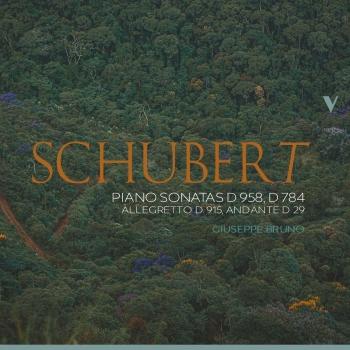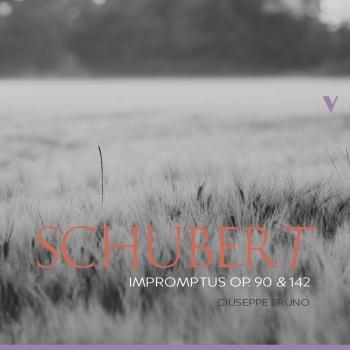
Schubert: Piano Sonatas, D. 157 & 960 Giuseppe Bruno
Album Info
Album Veröffentlichung:
2019
HRA-Veröffentlichung:
06.12.2019
Label: OnClassical
Genre: Classical
Subgenre: Instrumental
Interpret: Giuseppe Bruno
Komponist: Franz Schubert (1797 - 1828)
Das Album enthält Albumcover
- Franz Schubert (1797 - 1828): Piano Sonata in E Major / B Major, D. 157:
- 1 Piano Sonata in E Major / B Major, D. 157: I. Allegro ma non troppo 08:08
- 2 Piano Sonata in E Major / B Major, D. 157: II. Andante 08:12
- 3 Piano Sonata in E Major / B Major, D. 157: III. Menuetto. Allegro vivace - Trio 04:44
- Piano Sonata in B-Flat Major, D. 960:
- 4 Piano Sonata in B-Flat Major, D. 960: I. Molto moderato 22:49
- 5 Piano Sonata in B-Flat Major, D. 960: II. Andante sostenuto 11:28
- 6 Piano Sonata in B-Flat Major, D. 960: III. Scherzo. Allegro vivace con delicatezza - Trio 04:35
- 7 Piano Sonata in B-Flat Major, D. 960: IV. Allegro ma non troppo 08:46
Info zu Schubert: Piano Sonatas, D. 157 & 960
In 1815, barely eighteen years old and filled with enthusiasm, Franz Schubert ventured into writing his first sonata for piano. As a form, the sonata was seeing a marked decline in the early nineteenth century. But Schubert was honing his craft, and writing sonatas was part of both a creative process and an exercise in compositional skills. In this first sonata, in the key of E Major and catalogued as D 157, Schubert makes use of features that may mirror the concerns with technical dexterity that were pervasive at the time: the first movement, brilliant in character, opens with arpeggios and scales, but the entire structure in strict sonata form is characterized by a keen curiosity in exploring different technical devices. The second movement opens with a melody of lyrical simplicity that foreshadows some of the composer’s later inspirations, eventually gaining polyphonic complexity in its development. The third and last movement, a Menuet and Trio in the key of B Major, re-proposes the brilliance of the first movement, but leaves us wondering whether a fourth movement was planned, not only because a closing rondo may be expected, but also because of the unusual use of the dominant key to close the sonata.
To this first attempt, pianist Giuseppe Bruno juxtaposes what is considered Schubert’s last work – the Sonata in B-flat Major, D 960. A series of public performances in 1828 had brought Schubert greater recognition and financial stability, and as a result he worked feverishly to complete a large body of music, including three large-scale sonatas for piano, the symphonies Nos. 9 and 10, the Fantasie in F Minor for piano four-hands, and the String Quintet in C Major. Composed between the spring and fall of that year, the Sonata in B-flat Major features four movements centered on the main key, with a deviation to C-sharp minor in the Andante movement. The work was published posthumously ten years later, but for decades it remained underappreciated, chiefly because of its proportions and structural openness (the opening movement, much as other works written in that period, was particularly criticized for its meandering modulatory episodes). It was only in the twentieth century that the work was given the relevance it deserves, guaranteeing Schubert’s immortality.
Italian pianist Giuseppe Bruno continues his exploration of Schubert’s complete piano works in this recording, captured at the Saletta Acustica 'Eric James', Italy, by four Brüel & Kjaer microphones under the assistance of engineer Alessandro Simonetto.
Giuseppe Bruno, piano
Giuseppe Bruno
graduated with honors in Piano, Composition and Conductorship with Professors Specchi, Zangelmi and Taverna. Maestro Bruno specialized in piano with Paolo Bordoni and in conductorship with Leopold Hager. He has attended a seminar in composition at the IRCAM in Paris. Performing for several years as a pianist in many different chamber ensembles as well as a brilliant soloist. He has played with many important orchestras in Italy, USA, Greece, Romania and Germany in a repertory that goes from Mozart to Dallapiccola. From 1987 to 1992 he participated in the “Due Mondi” festival in Spoleto Italy and in 1988 in the Charleston festival in the USA.
In 1991 Maestro Bruno received an award at the International Piano Contest in Rome and in 1992 he received a second award in a duo with violin player Alberto Bologni at the “Viotti” in Vercelli, Italy. He recorded for Nuova Fonit Cetra, Diapason, SAM, Bongiovanni, Ars publica, Ars Musici, as well as for RAI, Swiss French and Italian radio and for WDR in Koeln. He collaborated with directors including Alkis Baltas, Spiros Argiris, Franz Lamprecht, Corneliu Dumbraveanu, violin player Sashko Gawriloff, singers Gail Gilmore and Victor von Halem, and with the Octet of Berlin Philharmonic. He is currently a member of the “Trio Petrarca”. In the past few years he has been acknowledged as a highly regarded conductor in Italy and abroad. Maestro Bruno is at present the Director of the "Giacomo Puccini" Conservatory, in La Spezia, Italy.
Dieses Album enthält kein Booklet















